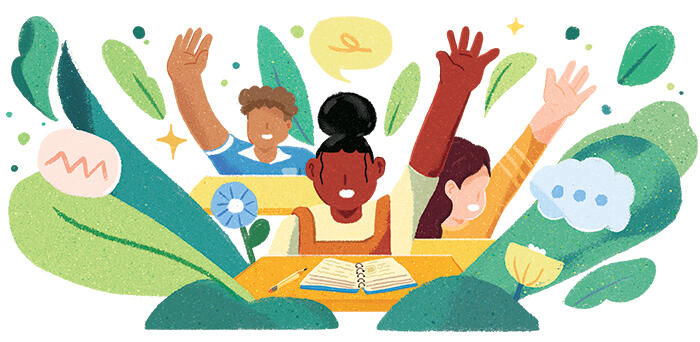“Make textbooks better.” That was the blunt imperative in Learning for Justice’s Teaching Hard History: American Slavery, a study that examined how American slavery is taught in U.S. schools and what needs to change for it to be accurately taught. Improving textbooks was one recommendation in the report.
Classroom educators agree there’s a lot of room for improvement.
“When I came into the classroom, there were textbooks in my rooms for me to use that are approved by our state,” says Ciara Hart, an eighth grade history teacher in Louisiana. “I took all the textbooks and put them on a cart and took them to the library because I went to the slavery section to read how they interpreted that history, and I wasn’t pleased with what I read.
“They’re all sitting in the library right now, collecting dust.”
Slavery was—and is—more than “a chapter” in U.S. history. It was central to the economic and social development of the colonies and was the prime driver of the nation’s wealth. Its principal legacy, racism, has shaped virtually everything: social, economic and educational inequality; housing, health care and labor policy; domestic terrorism, policing and mass incarceration; and so much more. To help students understand the enormity of slavery’s role is to equip them with the tools to contest the injustices of the present. Thus, slavery can’t be contained to a chapter in a textbook either.
Textbooks fall short in how they teach slavery and its legacy. But in the hands of a skilled educator, they can still be a useful teaching tool, especially in combination with other resources. Many educators effectively incorporate them in teaching the whole, hard history of the U.S. Learning for Justice talked to 19 educators in seven states about how they use textbooks in their classrooms.
Besides uncovering an abundance of useful examples, these interviews underscore the essential role of teacher agency in guiding students to understand the past and its connection to the present. Christopher Rogers, who heads up the curriculum work of Black Lives Matter at School, sums it up like this: “We are professionals, and in owning our practice, we also own the right to determine what is the proper and most effective and relevant way to reach our students.”
Professional expertise and agency are especially important now, when teachers are navigating not just flawed textbooks but also political backlash against teaching the truth about U.S. history.
The change we need in the textbooks is one that they’re not willing to make—because they’re not ready to have that conversation.
— N’Kengé Robertson
Textbooks are embedded white supremacist structures.
Brian Ford teaches U.S. history at Montclair High School in New Jersey and is part of the BLM at School curriculum team. Like Ciara Hart, he is sharply critical of textbooks. “Slavery isn’t situated in the broader historical conversation about the construction of race and racism in America,” he says.
Ford’s colleague in the MHS history department, Shana Stein, teaches from Reconstruction to the present. “Where I start, there is no mention [in the textbook] of slavery at all anymore,” she says. “The impression that a student has is that slavery ended in 1865 with the 13th Amendment—end of story.” For instance, when the book discusses sharecropping, the Black Codes and the origins of Jim Crow, “there’s no mention of enslavement,” Stein explains.
Hart’s critique is that textbooks disregard the perspectives of the enslaved. “I think there are meaningful ways you can do that,” she says, “so students are able to understand capitalism and the economic impact of all those things” without stripping away the humanity of the people involved and reducing it to “the beef between the North and the South.”
The failure to adequately explain the centrality of slavery to the formation and shaping of the nation and the lack of content that gives agency to the enslaved are also identified in the Teaching Hard History textbook review.
These failures are directly related to the fact that textbooks are a multibillion-dollar industry in the U.S. Traditional textbooks from the major publishers are not marketed to teachers, students or schools. They are marketed to state education boards, which are political entities controlled by states’ executive branches. In part because of this, textbook publishers are risk-averse and avoid anything that might cause “controversy.”
But “controversy” in the context of the largely unexamined white supremacist assumptions that shape our national narratives boils down to anything that challenges those assumptions. Textbooks present information in ways that obscure the agency of those who built, maintained and enforced the system of slavery—and that’s a problem.
“They often don’t have active verbs of people actually enslaving other people,” says historian David Gerwin. “They talk about slavery in the Americas, rather than a particular person who [enslaved people] or a particular legislative act.”
“It’s not ever going to change because the change we need in the textbooks is one that they’re not willing to make—because they’re not ready to have that conversation,” says N’Kengé Robertson, a high school English language arts teacher in Detroit who has also taught African American history and is a member of the BLM at School curriculum team.
In short, textbooks are structurally connected to the same racial capitalism whose legacy runs from 1619 to George Floyd to today. It is impossible to truly fix textbooks without also fixing the political, economic and social structures in which they are embedded.
Let students’ questions shape lessons.
But textbooks are a fact of life, and most history teachers use them either because of requirements to do so or because of time constraints. Forgoing the pre-packaged textbook and supplemental materials that come with them means a significant amount of additional work for teachers. Depending on a teacher’s experience, number of students and other workload factors, some are simply not able to do that.
Thus, the critical question for most teachers is how to use textbooks when teaching about slavery and its legacy effectively.
Stein has taught both AP history and honors history. The latter gives her more freedom, and she uses the textbook less frequently in that class. But there are still times when the book is helpful in providing background.
“Sometimes the textbook even has good suggestions for understanding questions, but I always add my own questions,” she says. “We do these sort of textbook talk-backs, where I always say, ‘Who is not represented? Whose story isn’t being told and why?’” Together, Stein says, she and her students “read between the lines”; in the process, she is using the textbook to teach critical reading and thinking skills.
She recalls with delight a student who, unprompted, started keeping a Google Doc of “all the things she felt the textbook got wrong.” Some of these items generated robust classroom discussion, and at the end of the year, the class read through the whole document together.
Many teachers use supplemental sources “in conversation with the textbook,” as Joe Costello put it. Costello teaches eighth-grade social studies in Union, New Jersey, and frequently turns to Learning for Justice for those materials. For her part, Stein uses resources from the Zinn Education Project, the Stanford History Education Group and Facing History and Ourselves. Robertson recommended the book Teaching for Black Lives from Rethinking Schools.
Many additional sources exist, such as The 1619 Project Education Network, BLM at Schools’ collection of classroom resources and a constantly expanding universe of digitized primary sources.
Jordan Lanfair, a former Chicago teacher and current teacher trainer, jokes that he has a “hate/hate relationship” with textbooks. Despite that, he finds them useful as a “springboard.”
“We need some foundation that all of us can access, a jumping-off point,” Lanfair says. From there, what is crucial for him is allowing students’ questions in response to the textbook to shape the lessons. “Let your students ask every question that comes up. Go for it. Let’s explore that. It’s like, ‘But why did that happen?’ ‘I don’t know. Let’s put it on the board.’ That is our big question for homework then.”
Educators are sometimes told to “squash down” questions, Lanfair says, but teachers need to do the opposite. “[Students] are going to think them, so let’s bring that in. Let’s chase up those answers.”
In helping students “chase up” answers, Lanfair drew on various additional sources.
In teaching about slavery, Lanfair started with Columbus and the occasion of Columbus Day/Indigenous Peoples Day, which conveniently falls early in the school year. His students looked at proclamations from individual cities and diaries from Columbus’ crew members. For a teacher with less time to spend on a Columbus Day lesson, he recommends pulling sources from online museum archives.
Like Lanfair, John Skelton sees value in starting with the textbook to provide “common language, what happened, when it happened, maybe some of the aspects of why it happened.”
Skelton teaches high school history in Charlottesville, Virginia, where the 2017 Unite the Right white supremacist rally galvanized the Albemarle County School Division (where Charlottesville is located) to develop both a system-wide anti-racism policy and a new social studies curriculum, Reframing the Narrative. The curriculum is structured around the Inquiry Design Model, which centers the students’ agency in the learning process by building lessons around questions that students explore. (See this issue’s PD Café for more on using the Inquiry Design Model to teach about slavery.)
“What the inquiries allow us to do is restructure the conversation around a different lens,” says Skelton. For example, the curriculum’s Reconstruction inquiry asks the question, “How did African Americans construct freedom during the Reconstruction era?” Focusing on the agency of the people at the heart of Reconstruction in this way stands in sharp contrast to textbook approaches, which center actors like Congress. The inquiry draws on curated primary sources and gives students a “more complex understanding of the human aspects of the different components that make up this era,” says Skelton.
Ask the hard questions.
The Reframing the Narrative curriculum is so named precisely because the dominant narrative—reflected in textbooks—needs correction. The educators featured here and many others across the country are doing this kind of reframing work every day in their classrooms, sometimes “talking back” to textbooks and sometimes bypassing them.
This classroom praxis of reframing U.S. history is part of a larger wave of innovation and activism among educators, and it has drawn intense backlash. Efforts to keep accurate history out of schools are ricocheting across the country, fueled by racist fearmongering and deliberate misinformation. In November 2021, PEN America reported that, in the first nine months of the year alone, 24 legislatures had introduced 54 state bills restricting teaching.
Speaking at The New York Times’ December 2021 event on teaching The 1619 Project, Nikole Hannah-Jones, the project’s creator, noted widespread “defiance among educators who are determined to teach what they think is appropriate, what they think is right” in the face of this backlash. That defiance was evident among the educators interviewed for this piece—along with incredible creativity and joy at leading students to connect the dots and understand the past and present alike.
Ultimately, it’s the professionalism and agency of educators—what BLM at School’s Rogers calls “owning our practice”—that is the target of the rightwing backlash. Agency and professionalism are also the key to teaching the truth despite it.
“What resources you have to use is not necessarily what you have to teach,” says Lanfair. “They gave me the resources, but you can’t tell me how to do instruction. And I just ask a lot of questions.”
And Hart centers why questioning is so vital: “I want [my students] to ask critical questions of the country they live in—ask the hard questions so that they can really develop and be active members of society.”




0 COMMENTS